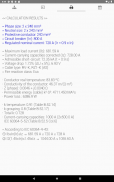


















InstElectric - Electricity

Perihal InstElectric - Electricity
Tool to support the calculation of electrical installations that will allow the user (designer / electrician / technician) to perform electrical calculations easily and quickly.
· Dimensioning complete of low voltage circuits with the most frequent installation methods
· Phase cable size, neutral, protective conductor
· Criteria based on the admissible current of the cable, voltage drop and overcurrent protection
· Designation of the most used cables.
· Circuits with automatic circuit breaker until In = 4000 A (Ir rating setting), maximum fuse In = 1600 A (gG type), maximum 12 conductors parallel per phase, maximum size 630 mm²
· Estimate of the maximum short-circuit current (simplified method)
· Forecast of loads of a building destined to houses with several sections: dwellings, common services, commercial premises/offices and garage with/without infrastructure for recharging electric vehicles
· Reactive power of the capacitor bank for the compensation of the power factor (cos φ) and capacity (µF) of the capacitors
· C/K Factor for automatic capacitor bank
· Choice of installation system in the function of the circuit, cable and its situation
· Power in an unbalanced three-phase system
· Overvoltages due to loss of neutral conductor, earth fault and short circuit
· Electricity parameters of a single-phase or three-phase (balanced)
· Transformer performance
· Secondary voltage of a transformer acoording to switch position
· Size of trays and conduits
· Conduits characteristics according to the installation method
· Conversions of wire sizes (mm²-awg) and conduits threads
Parameter settings for calculations:
· Constants (voltages, conductivity, temperatures, etc.) that affect electrical calculations
· Protections (circuit breakers and fuses)
· Selection of minimum rate for circuit-breakers with regulation and maximum cable size for multi-conductor grouping per phase
· Method estimation of the reactance
· Conductivity of the conductor depending on the current of the circuit (constant, according to the expected current, maximum cable temperature)
· Use reduction factors by grouping cables/circuits
· Use of factors of diversity/utilization
· Reference documents: IEC Standards, REBT (sp), Technical Application Guide, (UE) 2016/364
IN NO CASE SHALL THE AUTHOR BE LIABLE FOR ANY DIRECT OR INDIRECT DAMAGES AS A RESULT OF THE CORRECT OR INCORRECT USE OF THE APPLICATION
Alat untuk menyokong pengiraan pemasangan elektrik yang akan membolehkan pengguna (pereka / juruelektrik / juruteknik) untuk melakukan pengiraan elektrik dengan mudah dan cepat.
· Dimensioning lengkap litar voltan rendah dengan kaedah pemasangan yang paling kerap
· Saiz kabel fasa, neutral, konduktor pelindung
· Kriteria berdasarkan semasa yang boleh diterima kabel, penurunan voltan dan perlindungan overcurrent
· Penetapan kabel yang paling banyak digunakan.
· Litar dengan pemutus litar automatik sehingga In = 4000 A (tetapan penarafan Ir), fius maksimum In = 1600 A (gG type), maksimum 12 konduktor selari per fasa, saiz maksimum 630 mm²
· Anggaran litar pintas maksimum (kaedah mudah)
· Ramalan banyak bangunan yang ditakdirkan ke rumah dengan beberapa bahagian: kediaman, perkhidmatan umum, premis / pejabat komersil dan garaj dengan / tanpa infrastruktur untuk mengecas semula kenderaan elektrik
· Kuasa reaktif bank kapasitor untuk pampasan faktor kuasa (cos φ) dan kapasiti (μF) kapasitor
· C / K Factor untuk bank kapasitor automatik
· Pilihan sistem pemasangan dalam fungsi litar, kabel dan keadaannya
· Kuasa dalam sistem tiga fasa tidak seimbang
· Overvoltages akibat kehilangan konduktor neutral, kesalahan bumi dan litar pintas
· Parameter elektrik fasa tunggal atau tiga fasa (seimbang)
· Prestasi transformer
· Voltan sekunder pengubah acoording untuk kedudukan suis
· Saiz dulang dan saluran
· Ciri-ciri konduktif mengikut kaedah pemasangan
· Penukaran saiz wayar (mm²-awg) dan benang saluran
Tetapan parameter untuk pengiraan:
· Pemalar (voltan, kekonduksian, suhu, dan lain-lain) yang mempengaruhi pengiraan elektrik
· Perlindungan (pemutus litar dan fius)
· Pemilihan kadar minimum untuk pemutus litar dengan peraturan dan saiz kabel maksimum untuk pengelasan pelbagai konduktor setiap fasa
· Pengiraan kaedah reaktansi
· Konduktiviti konduktor bergantung kepada arus litar (berterusan, mengikut suhu kabel maksimum semasa yang diharapkan)
· Gunakan faktor pengurangan dengan mengelompokkan kabel / litar
· Penggunaan faktor kepelbagaian / penggunaan
· Dokumen rujukan: Standard IEC, REBT (sp), Panduan Aplikasi Teknikal, (UE) 2016/364
DALAM TIDAK ADA KERUSAKAN TIDAK AKAN BERTANGGUNGJAWAB UNTUK SEBARANG KEROSAKAN TANPA LANGSUNG ATAU TIDAK LANGSUNG SEBAGAI HASIL DENGAN BURUK ATAU PENGGUNAAN KESALAHAN APLIKASI

























